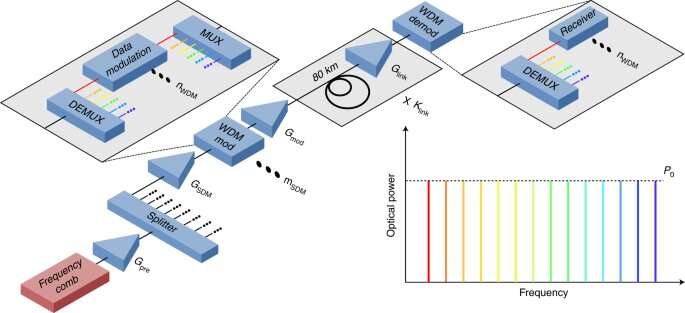Graphical abstract. Credit: Nature Photonics (2022). DOI: 10.1038/s41566-022-01082-z
A team of researchers with members from several institutions in Denmark, Sweden and Japan has developed a means for sending 1.84 petabits of data per second via a fiber-optic cable over 7.9 km. Their report is published in Nature Photonics.
As applications used across the internet mature, moving ever larger amounts of data has become a critical issue. In this new effort, the researchers have developed a single chip that is capable of handling nearly two petabits of data per second.
The chip the researchers built and demonstrated is based on the use of photonics rather than electronics. To transfer huge amounts of data quickly, they added technology to their chip that first splits an incoming data stream (from a laser) into 37 individuals lines that travel across individual threads in a fiber cable. But prior to sending, the data in each of the 37 streams was split into 223 individual chunks of data, each corresponding to a unique part of the optical spectrum.
This, the researchers noted, allowed for the creation of a frequency comb, by which data was transmitted in different colors through the fiber cable. In addition to transferring huge amounts of data quickly, it also prevents the data streams from interfering with each other. The researchers then put their chip into an optical processing device, which they describe as about the size of a matchbox—they describe the result as a "massively parallel space-and-wavelength multiplexed data transmission" system.
To test their device, the researchers hooked it up to another device that fed it multiple channels of data. On the other end, they connected a fiber cable that stretched for nearly 8 kilometers, where it met with another device that measured the amount and quality of the data received. The researchers note that adding their new device to the internet would not require any new transmission media—the standard fiber cables currently in use are compatible.
More information: A. A. Jørgensen et al, Petabit-per-second data transmission using a chip-scale microcomb ring resonator source, Nature Photonics (2022). DOI: 10.1038/s41566-022-01082-z
Journal information: Nature Photonics
© 2022 Science X Network
























